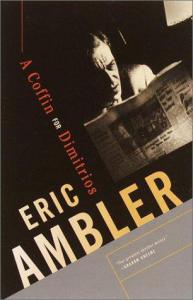Books |
A Coffin for Dimitrios
Eric Ambler
By
Published: Jun 22, 2014
Category:
Fiction
Graham Greene: “unquestionably our best thriller writer.”
John le Carré: “the source on which we all draw.”
Alfred Hitchcock: “Eric Ambler is a phenomenon.”
And perhaps the ultimate endorsement: In the film of “From Russia With Love,” when James Bond decides to read a book, he chooses Ambler’s most celebrated novel, “A Coffin For Dimitrios.”
John le Carré and Alan Furst have perfected the genre, but after Maugham’s spy stories launched the well written thriller, Ambler became its godfather.
We haven’t read older mysteries, but in the 1930s, Ambler represented a sharp turn from tradition. In the books he grew up reading, Ambler wrote, you could expect to find “the black-velveted seductress, the British secret-service numbskull, the omnipotent spymaster.” The villains would be implausible. As would be the hero: “All he really needed to function as hero was abysmal stupidity combined with superhuman resourcefulness and unbreakable knuckle bones.”
After decades of avoidance, I plunged into “A Coffin for Dimitrios.” Yes, it is worlds away from traditional English mysteries. And yes, it is that good. A bit too talky in the last hundred pages — but what isn’t?
The hero — though that’s overstating things considerably – is Charles Latimer. When he was 30, he was a lecturer in political economy at a minor English university. By 35, he’d published three deadly books of scholarship. Then he wrote a detective novel, “A Bloody Shovel.” It was a howling success. Two more followed. He quit his job and became a fulltime thriller writer, “one of the shamefaced few who could make money at the sport.”
At the start of the book, Latimer is in Turkey, avoiding English weather. He meets a high level police official who has an idea for a stupid detective story. In fact, he’s anything but dumb. “The important thing to know about an assassination,” he tells Latimer, “is not who fired the shot, but who paid for the bullet.” And then he shows Latimer the corpse of Dimitrios Makropoulos, who was knifed to death and thrown into the Bosphorus.
Dimitrios Makropoulos — gangster, drug-runner, murderer — fascinates Latimer. Instead of making up a story, he decides to dabble in biography and investigate a real life. And off he goes, on a quest that is not destined to make him popular. [To buy the paperback from Amazon, click here. For the Kindle edition, click here.]
Like Alan Furst, Ambler uses actual events in his plots. And not pretty ones. Here he describes the Turks’ burning and massacre of Armenians in 1922:
Dragged from their houses and hiding places, men, women and children were butchered in the streets… The wooden walls of the churches, packed with refugees, were drenched with benzene and fired. The occupants who were not burnt alive were bayoneted as they tried to escape.
Later, he takes you inside an assassination plot, offering tart commentary along the way:
The difference between Dimitrios and the more respectable type of successful businessman is only a difference of method –– legal method or illegal method. Both are in their respective ways equally ruthless.
Is there a gun? Yes, but you’ll be surprised by who holds it. Are there plenty of twists? Yes, and you can’t see them coming. Does the ending satisfy? Very much.
What impressed me the most? How a novel published in 1939 could sound as if it was just released. Like this, for example:
In a dying civilization, political prestige is the reward not of the shrewdest diagnostician, but of the man with the best bedside manner. It is the decoration conferred on mediocrity by ignorance.
I might have written that. I wish I had.


